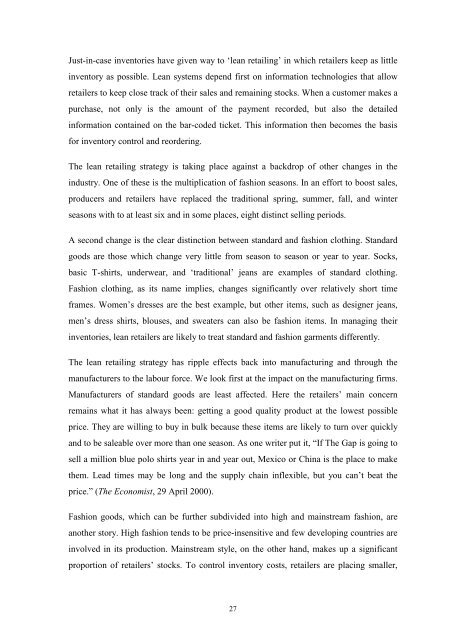McCormick+Schmitz Handbook for value chain research on - PACA
McCormick+Schmitz Handbook for value chain research on - PACA
McCormick+Schmitz Handbook for value chain research on - PACA
Create successful ePaper yourself
Turn your PDF publications into a flip-book with our unique Google optimized e-Paper software.
Just-in-case inventories have given way to ‘lean retailing’ in which retailers keep as little<br />
inventory as possible. Lean systems depend first <strong>on</strong> in<str<strong>on</strong>g>for</str<strong>on</strong>g>mati<strong>on</strong> technologies that allow<br />
retailers to keep close track of their sales and remaining stocks. When a customer makes a<br />
purchase, not <strong>on</strong>ly is the amount of the payment recorded, but also the detailed<br />
in<str<strong>on</strong>g>for</str<strong>on</strong>g>mati<strong>on</strong> c<strong>on</strong>tained <strong>on</strong> the bar-coded ticket. This in<str<strong>on</strong>g>for</str<strong>on</strong>g>mati<strong>on</strong> then becomes the basis<br />
<str<strong>on</strong>g>for</str<strong>on</strong>g> inventory c<strong>on</strong>trol and reordering.<br />
The lean retailing strategy is taking place against a backdrop of other changes in the<br />
industry. One of these is the multiplicati<strong>on</strong> of fashi<strong>on</strong> seas<strong>on</strong>s. In an ef<str<strong>on</strong>g>for</str<strong>on</strong>g>t to boost sales,<br />
producers and retailers have replaced the traditi<strong>on</strong>al spring, summer, fall, and winter<br />
seas<strong>on</strong>s with to at least six and in some places, eight distinct selling periods.<br />
A sec<strong>on</strong>d change is the clear distincti<strong>on</strong> between standard and fashi<strong>on</strong> clothing. Standard<br />
goods are those which change very little from seas<strong>on</strong> to seas<strong>on</strong> or year to year. Socks,<br />
basic T-shirts, underwear, and ‘traditi<strong>on</strong>al’ jeans are examples of standard clothing.<br />
Fashi<strong>on</strong> clothing, as its name implies, changes significantly over relatively short time<br />
frames. Women’s dresses are the best example, but other items, such as designer jeans,<br />
men’s dress shirts, blouses, and sweaters can also be fashi<strong>on</strong> items. In managing their<br />
inventories, lean retailers are likely to treat standard and fashi<strong>on</strong> garments differently.<br />
The lean retailing strategy has ripple effects back into manufacturing and through the<br />
manufacturers to the labour <str<strong>on</strong>g>for</str<strong>on</strong>g>ce. We look first at the impact <strong>on</strong> the manufacturing firms.<br />
Manufacturers of standard goods are least affected. Here the retailers’ main c<strong>on</strong>cern<br />
remains what it has always been: getting a good quality product at the lowest possible<br />
price. They are willing to buy in bulk because these items are likely to turn over quickly<br />
and to be saleable over more than <strong>on</strong>e seas<strong>on</strong>. As <strong>on</strong>e writer put it, “If The Gap is going to<br />
sell a milli<strong>on</strong> blue polo shirts year in and year out, Mexico or China is the place to make<br />
them. Lead times may be l<strong>on</strong>g and the supply <str<strong>on</strong>g>chain</str<strong>on</strong>g> inflexible, but you can’t beat the<br />
price.” (The Ec<strong>on</strong>omist, 29 April 2000).<br />
Fashi<strong>on</strong> goods, which can be further subdivided into high and mainstream fashi<strong>on</strong>, are<br />
another story. High fashi<strong>on</strong> tends to be price-insensitive and few developing countries are<br />
involved in its producti<strong>on</strong>. Mainstream style, <strong>on</strong> the other hand, makes up a significant<br />
proporti<strong>on</strong> of retailers’ stocks. To c<strong>on</strong>trol inventory costs, retailers are placing smaller,<br />
27














